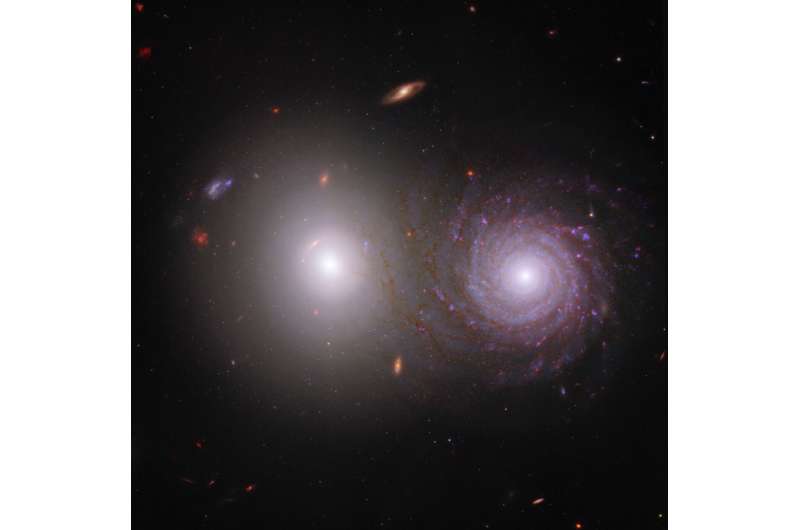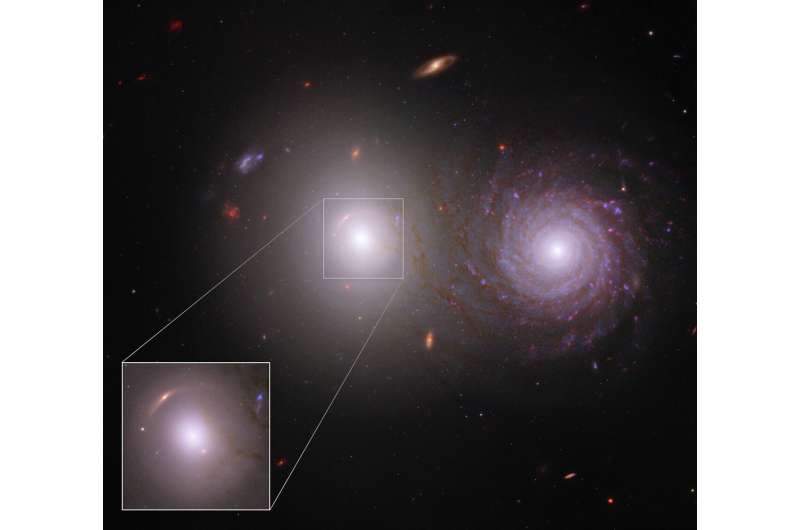Researchers traced light that was emitted by the bright white elliptical galaxy on the left through the spiral galaxy at right. As a result, they were able to identify the effects of interstellar dust in the spiral galaxy. Webb’s near-infrared data also show us the galaxy’s longer, extremely dusty spiral arms in far more detail, giving them an appearance of overlapping with the central bulge of the bright white elliptical galaxy on the left, though the pair are not interacting. In this image, green, yellow, and red were assigned to Webb’s near-infrared data taken in 0.9, 1.5, and 3.56 microns (F090W, F150W, and F356W respectively). Blue was assigned to two Hubble filters, ultraviolet data taken in 0.34 microns (F336W) and visible light in 0.61 microns (F606W). Credit: NASA, ESA, CSA, Rogier Windhorst (ASU), William Keel (University of Alabama), Stuart Wyithe (University of Melbourne), JWST PEARLS Team
This article highlights data from Webb science in progress, which has not yet been through the peer-review process. Here, Webb interdisciplinary scientist Rogier Windhorst and his team discuss their observations.
"We got more than we bargained for by combining data from NASA's James Webb Space Telescope and NASA's Hubble Space Telescope! Webb's new data allowed us to trace the light that was emitted by the bright white elliptical galaxy, at left, through the winding spiral galaxy at right—and identify the effects of interstellar dust in the spiral galaxy. This image of galaxy pair VV 191 includes near-infrared light from Webb, and ultraviolet and visible light from Hubble."
"Webb's near-infrared data also show us the galaxy's longer, extremely dusty spiral arms in far more detail, giving the arms an appearance of overlapping with the central bulge of the bright white elliptical galaxy on the left. Although the two foreground galaxies are relatively close astronomically speaking, they are not actively interacting."
"VV 191 is the latest addition to a small number of galaxies that helps researchers like us directly compare the properties of galactic dust. This target was selected from nearly 2,000 superimposed galaxy pairs identified by Galaxy Zoo citizen science volunteers."
Above the white elliptical galaxy at left, a faint red arc appears in the inset at 10 o'clock. This is a very distant galaxy whose appearance is warped. Its light is bent by the gravity of the elliptical foreground galaxy. Plus, its appearance is duplicated. The stretched red arc is warped where it reappears—as a dot—at 4 o'clock. In this image, green, yellow, and red were assigned to Webb's near-infrared data taken in 0.9, 1.5, and 3.56 microns (F090W, F150W, and F356W respectively). Blue was assigned to two Hubble filters, ultraviolet data taken in 0.34 microns (F336W) and visible light in 0.61 microns (F606W). Credit: NASA, ESA, CSA, Rogier Windhorst (ASU), William Keel (University of Alabama), Stuart Wyithe (University of Melbourne), JWST PEARLS Team
"Understanding where dust is present in galaxies is important, because dust changes the brightness and colors that appear in images of the galaxies. Dust grains are partially responsible for the formation of new stars and planets, so we are always seeking to identify their presence for further studies."
"The image holds a second discovery that's easier to overlook. Examine the white elliptical galaxy at left. A faint red arc appears in the inset at 10 o'clock. This is a very distant galaxy whose light is bent by the gravity of the elliptical foreground galaxy—and its appearance is duplicated. The stretched red arc is warped where it reappears—as a dot—at 4 o'clock. These images of the lensed galaxy are so faint and so red that they went unrecognized in Hubble data, but are unmistakable in Webb's near-infrared image. Simulations of gravitationally lensed galaxies like this help us reconstruct how much mass is in individual stars, along with how much dark matter is in the core of this galaxy."
"Like many Webb images, this image of VV 191 shows additional galaxies deeper and deeper in the background. Two patchy spirals to the upper left of the elliptical galaxy have similar apparent sizes, but show up in very different colors. One is likely very dusty and the other very far away, but we—or other astronomers—need to obtain data known as spectra to determine which is which."
More information: Related paper: webbtelescope.org/files/live/s … lensing-in-VV191.pdf
Related paper: webbtelescope.org/files/live/s … ew-First-Results.pdf
Provided by Webb Space Telescope

























